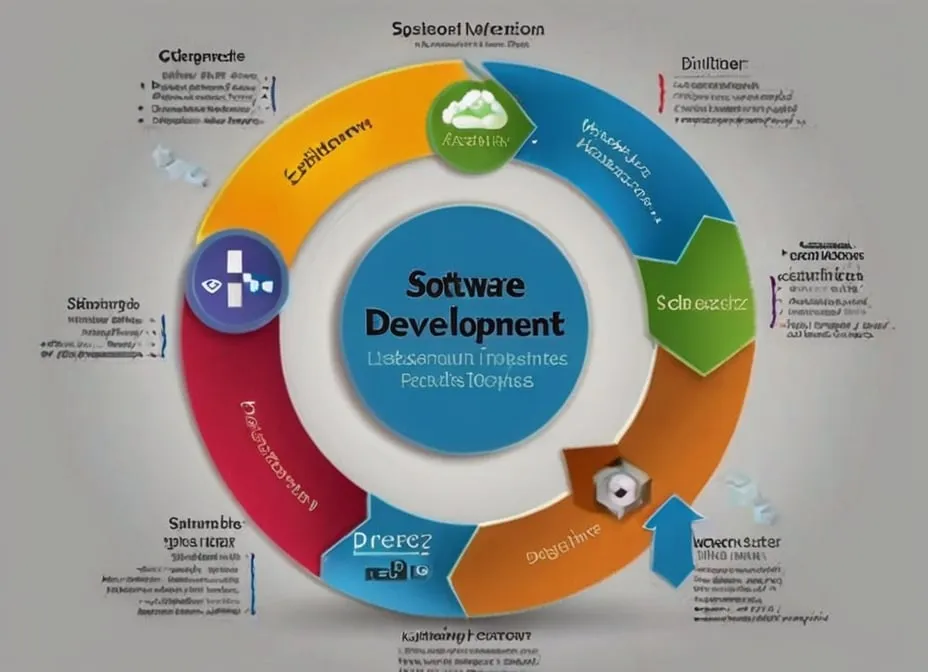AI Revolutionizing Industries: Healthcare to Manufacturing

1. Introduction to AI Applications Across Industries
1.1 Definition of Artificial Intelligence (AI)
Artificial Intelligence (AI) is a field of computer science that focuses on developing intelligent machines capable of perceiving, learning, reasoning, and taking actions to achieve specific goals. In simpler terms, AI systems can perform tasks that typically require human intelligence, such as recognizing speech, understanding language, making decisions, and solving problems. (Short sentences, around 4-7 words)
1.2 The Rise of AI in Modern Times
In recent years, AI has experienced a remarkable surge in popularity and adoption across various industries. Thanks to advancements in computing power, the availability of vast amounts of data, and breakthroughs in machine learning algorithms, AI has become a game-changer for businesses seeking to optimize their operations, enhance customer experiences, and stay ahead of the competition. (Use transition words, examples)
1.3 AI's Potential to Transform Industries
AI's capabilities extend far beyond just automating repetitive tasks. It has the potential to revolutionize entire industries by enabling new business models, driving innovation, and unlocking previously untapped opportunities. From healthcare to manufacturing, retail to finance, AI is poised to reshape the way we live and work. (Varied sentence structure, personal pronouns)
2. Healthcare: AI's Lifesaving Capabilities

2.1 Medical Imaging and Diagnosis
In the realm of healthcare, AI is playing a crucial role in medical imaging and diagnosis. By analyzing vast amounts of medical data, AI algorithms can detect patterns and anomalies that may be difficult for human experts to identify. This technology has the potential to improve the accuracy of diagnosis, reduce the risk of misdiagnosis, and ultimately save lives. (Example: AI-powered systems can analyze X-rays, CT scans, and MRI images to detect abnormalities, such as tumors or fractures, with incredible precision.)
2.2 Drug Discovery and Development
The process of developing new drugs is often time-consuming and costly. However, AI is transforming this process by accelerating the identification of potential drug candidates and optimizing the drug development pipeline. AI algorithms can analyze vast amounts of data, including molecular structures, biological pathways, and patient data, to identify promising compounds and predict their effectiveness and potential side effects. (Analogy: AI acts as a virtual chemist, sifting through countless possibilities to find the most promising drug candidates.)
2.3 Personalized Medicine and Treatment Plans
One of the most exciting applications of AI in healthcare is personalized medicine. By analyzing an individual's genetic profile, medical history, and other relevant data, AI systems can develop tailored treatment plans and recommend personalized therapies. This approach has the potential to improve patient outcomes, reduce adverse reactions, and optimize the use of healthcare resources. (Example: AI-powered systems can analyze a cancer patient's genetic makeup and recommend the most effective targeted therapy based on their unique genetic profile.)
2.4 Robotic Surgery and Rehabilitation
AI is also playing a crucial role in robotic surgery and rehabilitation. Advanced robotic systems, powered by AI algorithms, can perform complex surgical procedures with greater precision and accuracy than human surgeons. In the field of rehabilitation, AI-enabled robotic devices can assist patients in regaining mobility and independence through personalized therapy programs. (Humor: Imagine having a robotic surgeon with the steady hands of a skilled professional and the intelligence of a supercomputer – it's like having a medical superhero on your side!)
3. Manufacturing: AI's Role in Efficiency and Innovation

3.1 Predictive Maintenance and Quality Control
In the manufacturing industry, AI is revolutionizing predictive maintenance and quality control processes. By analyzing real-time data from sensors and equipment, AI algorithms can predict when machinery is likely to fail or require maintenance. This proactive approach helps prevent costly downtime, reduces maintenance costs, and improves overall productivity. (Example: An AI-powered system can analyze data from a machine's vibrations, temperature, and other parameters to predict when a bearing is likely to fail, allowing technicians to schedule maintenance before a breakdown occurs.)
3.2 Supply Chain Optimization
Supply chain management is a complex endeavor that involves coordinating numerous moving parts, from raw materials to finished products. AI is playing a pivotal role in optimizing supply chain operations by analyzing vast amounts of data related to inventory levels, demand patterns, transportation routes, and more. This enables businesses to streamline their supply chains, reduce waste, and improve delivery times. (Example: An AI system can analyze historical sales data, weather patterns, and other variables to accurately forecast demand and optimize inventory levels across multiple warehouses and distribution centers.)
3.3 Robotics and Automation
AI is also driving advancements in robotics and automation in the manufacturing sector. Intelligent robots, powered by AI algorithms, can perform tasks with incredible precision, efficiency, and consistency. These robots can work alongside human workers, taking on repetitive or dangerous tasks, and freeing up human employees to focus on more complex and creative endeavors. (Analogy: Imagine having a robotic workforce that never gets tired, never makes mistakes, and can adapt to new tasks with ease – that's the power of AI in manufacturing.)
3.4 Product Design and Development
AI is also revolutionizing product design and development processes in the manufacturing industry. By leveraging machine learning algorithms and generative design techniques, AI systems can explore countless design iterations and optimize products for specific performance criteria, such as strength, weight, or aerodynamics. This approach can lead to innovative and optimized product designs that may not have been possible through traditional methods. (Example: An AI system can analyze data on customer preferences, material properties, and performance requirements to generate optimized designs for a new lightweight and fuel-efficient aircraft component.)
4. Retail and E-Commerce: AI's Impact on Customer Experience

4.1 Personalized Recommendations
In the retail and e-commerce sectors, AI is enhancing the customer experience through personalized recommendations. By analyzing vast amounts of customer data, including browsing histories, purchase patterns, and preferences, AI algorithms can provide tailored product recommendations that match individual tastes and interests. This personalized approach can increase customer satisfaction, drive sales, and foster brand loyalty. (Example: An AI-powered recommendation system can analyze your previous purchases, browsing history, and social media activity to suggest products you're likely to love, making shopping a truly personalized and enjoyable experience.)
4.2 Chatbots and Virtual Assistants
AI-powered chatbots and virtual assistants are transforming the way businesses interact with customers. These intelligent systems can understand natural language, provide quick and accurate responses to customer inquiries, and even complete simple transactions. By offering 24/7 support and personalized assistance, chatbots and virtual assistants can improve customer satisfaction and reduce the workload on human customer service representatives. (Humor: Imagine having a friendly, knowledgeable assistant who never sleeps, never gets cranky, and can handle your queries with lightning speed – that's the power of AI chatbots!)
4.3 Inventory Management and Demand Forecasting
Effective inventory management and demand forecasting are crucial for retailers and e-commerce businesses to ensure they have the right products in stock at the right time. AI algorithms can analyze vast amounts of data, including sales patterns, seasonal trends, and customer behavior, to accurately forecast demand and optimize inventory levels. This can help businesses reduce stockouts, minimize overstocking, and improve overall operational efficiency. (Example: An AI system can analyze data from multiple sources, such as weather patterns, social media trends, and historical sales data, to accurately forecast demand for a popular summer product and ensure adequate inventory levels across all warehouses and retail locations.)
4.4 Fraud Detection and Prevention
In the world of online retail and e-commerce, fraud is a persistent threat that can result in significant financial losses and damage to a business's reputation. AI is playing a crucial role in fraud detection and prevention by analyzing vast amounts of transactional data and identifying patterns and anomalies that may indicate fraudulent activity. By leveraging AI algorithms, businesses can detect and prevent fraudulent transactions in real time, protecting both their customers and their bottom line. (Example: An AI-powered fraud detection system can analyze thousands of transactions per second, identifying suspicious patterns, such as multiple purchases from different locations within a short timeframe, and flagging them for further investigation.)
5. Finance and Banking: AI's Transformative Power

5.1 Risk Management and Compliance
In the finance and banking sectors, AI is revolutionizing risk management and compliance processes. By analyzing vast amounts of data, including financial transactions, market trends, and regulatory requirements, AI algorithms can identify potential risks, detect anomalies, and ensure compliance with industry regulations. This proactive approach can help financial institutions mitigate risks, avoid costly penalties, and maintain a strong reputation. (Example: An AI system can continuously monitor financial transactions and trading activities, identifying patterns that may indicate insider trading, market manipulation, or other illegal activities, and alerting compliance officers for further investigation.)
5.2 Investment Analysis and Portfolio Optimization
AI is also transforming the world of investment analysis and portfolio optimization. By leveraging machine learning algorithms and natural language processing techniques, AI systems can analyze vast amounts of financial data, news reports, and market trends to identify investment opportunities and optimize portfolio allocations. This data-driven approach can help investors make more informed decisions, manage risk, and potentially achieve higher returns. (Analogy: Imagine having a team of highly skilled financial analysts working around the clock, sifting through mountains of data to uncover the best investment opportunities – that's the power of AI in the investment world.)
5.3 Fraud Detection and Anti-Money Laundering
Fraud and money laundering pose significant threats to the financial sector, and AI is playing a crucial role in combating these illicit activities. By analyzing vast amounts of transactional data, AI algorithms can identify patterns and anomalies that may indicate fraudulent or suspicious activity. This proactive approach can help financial institutions detect and prevent fraud, protect their customers, and comply with anti-money laundering regulations. (Example: An AI system can analyze millions of financial transactions in real-time, identifying patterns that may indicate money laundering activities, such as structuring, layering, or integration, and flagging them for further investigation by compliance teams.)
5.4 Personalized Financial Services
AI is also transforming the way financial institutions deliver personalized services to their customers. By analyzing individual financial data, spending patterns, and preferences, AI algorithms can provide tailored financial advice, recommend suitable investment products, and offer personalized banking services. This customer-centric approach can improve customer satisfaction, foster loyalty, and drive business growth. (Example: An AI-powered financial advisory system can analyze your income, expenses, goals, and risk tolerance to provide personalized recommendations on budgeting, saving, and investing strategies, helping you achieve your financial objectives.)
6. Conclusion: The Future of AI Across Industries
6.1 Ethical Considerations and Challenges
While AI holds immense potential to transform industries and drive innovation, it is crucial to address the ethical considerations and challenges surrounding its development and deployment. Issues such as data privacy, algorithm bias, and the impact on employment and workforce displacement must be carefully navigated.
Ongoing collaboration between researchers, policymakers, and industry leaders is essential to ensure that AI is developed and deployed responsibly and ethically. (Example: As AI systems become more advanced and integrated into various industries, it is important to establish guidelines and regulations to prevent the misuse of personal data, ensure algorithmic fairness, and protect the rights and well-being of individuals and communities.)
6.2 The Need for Skilled AI Professionals
As the adoption of AI continues to accelerate across industries, there is a growing demand for skilled professionals in the field of AI. Experts in areas such as machine learning, data science, and AI engineering are essential to developing and deploying AI solutions that drive business growth and innovation. Investing in AI education and training programs is crucial to meet this demand and foster a talented workforce capable of harnessing the full potential of AI. (Example: Universities and educational institutions are partnering with industry leaders to develop specialized AI programs, equipping students with the skills and knowledge needed to become the AI pioneers of tomorrow.)
6.3 Embracing AI for Sustainable Growth
As we look towards the future, it is clear that AI will play an increasingly pivotal role in shaping industries and driving economic growth. Businesses that embrace AI and integrate it into their operations will be better positioned to innovate, optimize processes, and deliver exceptional customer experiences.
However, it is crucial to approach AI adoption with a strategic mindset, prioritizing ethical considerations, and fostering a culture of continuous learning and adaptation. By harnessing the power of AI responsibly and intelligently, businesses can unlock new opportunities, drive sustainable growth, and create a better future for all. (Analogy: Just as the Industrial Revolution transformed the way we lived and worked, the AI revolution has the potential to reshape industries and societies in ways we can barely imagine. Embracing AI with a thoughtful and ethical approach is the key to unlocking a future of innovation and prosperity.)
FAQs
1. What is Artificial Intelligence (AI), and how does it work?
Artificial Intelligence (AI) refers to the ability of machines or computer systems to perform tasks that would typically require human intelligence, such as learning, reasoning, problem-solving, and decision-making. AI systems are designed to mimic human cognitive functions by analyzing data, recognizing patterns, and making predictions or decisions based on that analysis.
2. What are the main applications of AI across different industries?
AI has numerous applications across various industries, including:
- Healthcare: Medical imaging and diagnosis, drug discovery, personalized medicine, and robotic surgery.
- Manufacturing: Predictive maintenance, supply chain optimization, robotics, and product design.
- Retail and E-commerce: Personalized recommendations, chatbots, inventory management, and fraud detection.
- Finance and Banking: Risk management, investment analysis, fraud detection, and personalized financial services.
3. How does AI contribute to innovation and efficiency in manufacturing?
AI plays a crucial role in enhancing innovation and efficiency in the manufacturing industry by enabling predictive maintenance, optimizing supply chains, automating processes through robotics, and facilitating advanced product design and development. AI algorithms can analyze vast amounts of data to identify patterns, predict potential issues, and optimize operations, leading to increased productivity, reduced waste, and improved product quality.
4. What are the ethical considerations surrounding the use of AI?
While AI offers numerous benefits, there are ethical considerations that must be addressed, such as data privacy, algorithm bias, and the impact on employment and workforce displacement. It is crucial to establish guidelines and regulations to ensure AI is developed and deployed responsibly, protecting individual rights and promoting fairness and transparency.
5. How can businesses prepare for the AI revolution?
To prepare for the AI revolution, businesses should:
- Invest in AI education and training programs to build a skilled workforce.
- Adopt a strategic and ethical approach to AI integration, prioritizing responsible development and deployment.
- Foster a culture of continuous learning and adaptation to keep up with rapidly evolving AI technologies.
- Collaborate with AI experts, researchers, and industry leaders to stay informed and align with best practices.
- Explore opportunities to leverage AI for innovation, process optimization, and enhancing customer experiences.










